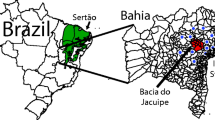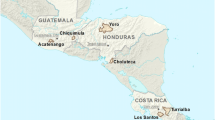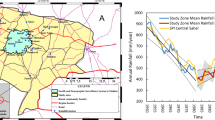Abstract
This study was undertaken to assess the potential impacts of climate change on agriculture in the Sikasso region of southern Mali, as part of an effort by the U.S. Agency for International Development (USAID) to integrate climate change adaptation considerations into their development projects. The region is considered to be the breadbasket of Mali, providing a substantial amount of the country’s food supplies as well as cotton for exchange earnings. The project had two components: modeling how climate change could affect production of cereal and cash crops in southern Mali; and conducting a stakeholder-driven vulnerability and adaptation assessment to identify potential options for addressing current and projected risks to agriculture from climate change. Projected changes in crop yields were based on a previous analysis that was extended for the purposes of this study. The projections suggested that the sensitivity of maize to changing weather conditions is relatively small (generally less than 10% change) under both dry and wet scenarios in 2030 and 2060. White (Irish) potatoes, the primary cash crop, are the most sensitive to changing weather conditions, with yields decreasing under both dry and wet conditions; yields could decrease by about 25% by 2060. Stakeholder workshops, field interviews, and an expert analysis were used to assess current and future climate-related vulnerability and to identify potential adaptation options. The main focus of the assessment was farmers in a village of about 3,000 people in the Sikasso region that practiced a rice-potato rotation system typical to the region. The farmers emphasized adaptation measures that require outside financial and technical assistance, for example installation of a water gate that would retain more water in the inland valley and increase the water table to flood rice fields during the rainy season and for furrow irrigation of potatoes during the dry season. Adaptations emphasized by both the farmers and representatives of regional technical services were crop diversification and germplasm improvement; soil and water management; access to equipment (plows, carts, oxen, and improved stoves); credit stockage villageois (CSV); and fertilizer.
Similar content being viewed by others
References
Butt TA, McCarl BA, Angerer J, Dyke PT, Stuth JW (2005) The economic and food security implications of climate change in Mali. Clim Chang 68:355–378
Christensen JH, Hewitson B, Busuioc A, Chen A, Gao X, Held I, Jones J, Kolli RK, Kwan W-T, Laprise R, Magaña V, Mearns L, Guillermo C, Räisänen J, Rinke A, Sar A, Whetton P (2007) Regional climate projections. In: Solomon S, Qin D, Manning M, Chen Z, Marquis M, Averyt KB, Tignor M, Miller HL (eds) (2007) Climate change 2007: the physical science basis. Contribution of Working Group I to the Fourth Assessment Report of the Intergovernmental Panel on Climate Change. Intergovernmental Panel on Climate Change. Cambridge University Press, New York
Cook K-H, Vizy EK (2006) Coupled model simulations of the West African Monsoon System: 20th century Simulations and 21st Century Predictions. J Clim 19:3681–3703
Doumbia M, Jarju A, Sène M, Traoré K, Yost R, Kablan R, Brannan K, Berthe A, Yamoah C, Querido A, Traoré PCS, Ballo A (2009) Sequestration of organic carbon in West African soils by Aménagement en Courbes de Niveau. Agron Sustain Dev 29(2):267–275
FAO (2007) Food security statistics. Available: www.fao.org/es/ess/faostat/foodsecurity/index_en.htm.
Jones PG, Thornton PK (2003) The potential impacts of climate change on maize production in Africa and Latin America in 2055. Glob Environ Chang 13(1):51–59
Kabubo-Mariara J (2007) Land conservation and tenure security in Kenya: Boserup’s hypothesis revisited. Ecol Econ 64(1):25–35
Leary N, Kulkarni J (2007) Climate change vulnerability and adaptation in developing country regions. Draft final report of the AIACC project. The International START Secretariat, UNEP. 195 pp.
Neill SP, Lee DR (2001) Explaining the adoption and disadoption of sustainable agriculture: the case of cover crops in northern Honduras. Econ Dev Cult Chang 49(4):793–820
Obilana A B, Okumu BN (2005) Africa-Asia Joint Research: Interspecific hybridization between African and Asian rice species, Evaluation study report. Prepared for UNDP SU/SSC and WARDA. 81 pp.
Sperling L, Remington T, Nagoda S (eds) (2004) Addressing seed security in disaster response: Linking relief with development, overview. International Center for Tropical Agriculture, Cali, Colombia. Available on-line at http://www.ciat.cgiar.org/africa/seeds.htm.
Wigley TML (2004) MAGICC/SCENGEN. Boulder, Colorado: National Center for Atmospheric Research. http://www.cgd.ucar.edu/cas/wigley/magicc/
Williams JR, Jones CA, Kiniry JR, Spanel DA (1989) The EPIC crop growth model. Trans ASAE 32:497–511
Author information
Authors and Affiliations
Corresponding author
Rights and permissions
About this article
Cite this article
Ebi, K.L., Padgham, J., Doumbia, M. et al. Smallholders adaptation to climate change in Mali. Climatic Change 108, 423–436 (2011). https://doi.org/10.1007/s10584-011-0160-3
Received:
Accepted:
Published:
Issue Date:
DOI: https://doi.org/10.1007/s10584-011-0160-3




